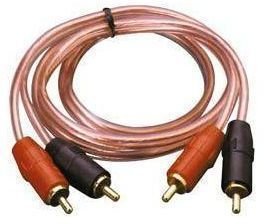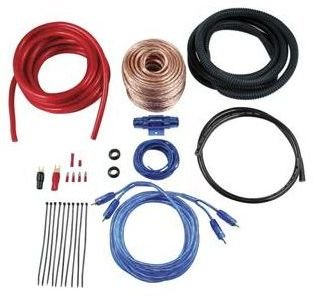How to Install an Amp and Subwoofer in Your Vehicle? Setting up Subwoofer Power
Getting Started
For someone just getting into the practice of beefing up your car audio, it’s a pretty common question to ask how you go about installing a subwoofer in a vehicle. However, the real question is how to install an amplifier in a car. Unless the subwoofer is powered, it’s the amp that requires all the wiring for the power and speaker connections. In this article, I’ll tell you how to do both.
Before you begin, you need to get an amplifier wiring kit. They cost about 30 dollars, give or take, and vary depending on wire gauge size. Check the manufacturer’s specifications for your size amp in order to see what gauge wire you need. The wiring kit should include a main power wire with an in-line fuse, a ground wire, a power-on wire for the stereo head unit, and RCA cables for the audio connection. Some kits also include the appropriate crimpers and clips so you won’t have to buy anything extra.
Power
The first thing you need to do is disconnect your car battery. Make sure your stereo doesn’t have any security features that might disable it if the power is cut, as some do require unlock codes. First, disconnect the negative terminal, then disconnect the positive terminal. You must do them in that order. Be very careful and try not to lean directly over the battery, as they can in rare cases actually explode.
Now you need to run the power cable. This cable connects the positive terminal of the battery directly to the amplifier, and it should have an in-line fuse to help protect the amp from power issues. This fuse should be removed before you connect the wires. What the fuse does is bridge the connection with the cables, so the other end of the power cable won’t be hot when you connect it to the amp.
The most difficult part of this whole process, in my opinion, is running the power cable because you have to go from the engine compartment to somewhere in the interior of the vehicle. I usually run my cables through the rubber gasket that allows all the other wires and cables to go through the dash to the engine compartment. If you look somewhere near the steering column, you should find a place to run the power cable and I don’t recommend drilling unless you absolutely have no other choice. Very carefully poke a small hole in that rubber gasket and feed the cable through.
You will need to snake the power cable under the dash and to wherever you have the amp, which is typically in the back of the car. If you have a center console in your vehicle, you can hide the cable under it. Just be very careful under your dash that you don’t obstruct your pedals or any other mechanical devices in any way. You may want to keep a few small zip ties on hand to secure the cable.
Ground
With the power cable in place, the next thing is run the ground wire. This short wire connects to the chassis of your vehicle and most people use a seat bolt to ground. Just take a bolt out of where the seat connects to the floor, then put the wire in place and screw the bolt back in. Make sure you got it nice and tight and that the ground wire is touching exposed metal. Painted metal may cause some grounding issues. If you absolutely must, you can drill a hole and install your own grounding, but be extremely careful when doing this.
Stereo Connections

Now that your amp has power, you need to connect it to your stereo so it can process the sound and send it on to the subwoofer. Most modern car decks have at least one set of RCA connectors on the back, and you just run the RCA cables from there to the amp. This is the easiest and most efficient way of connecting, and it doesn’t require any splicing. Just make sure you don’t run the RCA cables right next to your power cable, as this can cause audio interference like static. If you want to run speakers other than a subwoofer, you may also need to run more speaker wire from the amp to the speakers. Once you’ve got the audio input going into the amp, now you just run wire from the amp to the subwoofer.
Some stereos have a “power on” cable that runs to the amp and turns it on whenever the stereo is on. By default, the amp just comes on whenever the vehicle is started, but you may want to run the on/off cable in order to save battery power. It all depends on what kind of stereo you have and whether or not the connection is available.
Final Steps
Double check all your connections to make sure they are tight and secure, then reconnect the battery terminals in reverse order. Start by connecting the positive terminal, then connect the negative terminal. Again, be very careful doing this and make sure your connections are tight, but don’t over tighten or you could damage the soft metal that goes around the battery leads.
The very last step is to insert the in-line fuse, and you are ready to go. Now crank up your vehicle and get ready to start thumping. You may have to tweak the audio settings on your stereo, depending on what kind you have. I have a Kenwood CD/MP3 player that has a separate Subwoofer level adjustment in addition to the regular bass and treble controls. It usually takes a minute or two to adjust the sound the way you want, so pick one of your favorite songs for calibrating.
Safety Note
If you decide to later unhook your amp, don’t forget to first remove that in-line fuse. One time I forgot about that and took off the power cable, then let it touch the metal on the bottom of my car seat. It gave a nice spark and scared the heck out of me. Luckily, my in-line fuse took the hit and I didn’t fry the electrical system in my car, but I was very worried until I popped the hood and saw the charred black remains of that fuse.
This post is part of the series: Car Audio - Amps and Subwoofers
These articles are about adding a subwoofer and amplifier to your car audio system. They cover the basic different types of subwoofers, how to choose the best one for your needs, and how to install an amp and sub in your vehicle.
